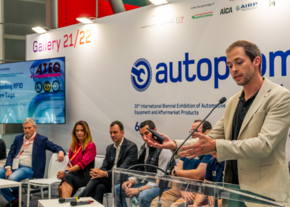
04/07/2018
Blockchain, possible applications in the automotive field
Dino Collazzo
The automotive industry has recently embarked on several experiments as far as data protection and management on connected vehicles. However, more applications are possible.
Blockchain technology appeals to the automotive world, so much so that several manufacturers are now studying its future impact on the industry as a whole. Field applications are numerous, from data protection and management on connected cars to developing new mobility systems, from digital payment protection to the transparent supply of spare parts as well as insurance settlements. But what exactly is Blockchain technology?
It is a decentralised communication protocol designed to create a large shared database to manage transaction through numerous computing “nodes” – each administrator of the blockchain – of the network. The database is structured in blocks within which several transactions are validated by a timestamp. Each block includes a hash ( a function that converts an input of letters and numbers into an encrypted output using an algorithm) that uniquely identifies the block and allows it to connect with the preceding one. The set of these blocks constitutes the ledger: a public register in which all transactions carried out in an orderly and sequential manner are noted with the utmost transparency and in an unchangeable manner. In essence the blockchain is a system that allows users to independently verify and protect transactions without the need for intermediaries and, as a consequence, speed up business processes. Its ability to ensure the highest level of data protection is what captured the interest of the automotive industry. In fact, the structure makes it almost impossible to add, remove or modify data once they have been validated and stored in a block. Basically, the chances of a hacker accessing what is stored in a blockchain are very low. Which makes it perfectly suitable to protect connected vehicles from cyber attacks.
According to insiders, around 250 million connected cars are expected to be in circulation around the globe by 2020. We are talking about vehicles equipped with highly developed sensors for autonomous driving, state-of-the-art infotainment systems and cloud-based IT processes. All elements that are prodding the automotive industry to adopt blockchain technology to manage and protect the huge amount of data that will be produced by these vehicles. In fact, in addition to being able to drive autonomously, they will also be able to update their software, pay tolls or refuelling charges and buy movies, apps and other services. As a result, protecting them means protecting individual drivers from theft or fraud. The adoption of this technology by the automotive sector therefore represents a competitive advantage, the long term effect of which will be a widespread diffusion of connected cars and greater business opportunities for manufacturers and the aftermarket supply chain as a whole.
The use of this technology in the automotive field, though, does not just revolve around vehicles. Possible applications, in fact, go well beyond, extending to the entire mobility sector. As the Internet of Things keeps gaining ground in the field of transport, with its increasingly smart vehicles and infrastructures, data protection has become a priority. In this case, road safety will be the central theme, linked to sensors scattered throughout increasingly smart cities, able to safely send information regarding traffic, possible accidents or a “collapsed bridge”, in real time and without the risk of being hacked.
The opportunities that lie behind the use of blockchain technology are countless and range in different fields and sectors. Further investments will likely concern the entire supply chain. In this case, the transparency offered by these "shared accounting books" will ensure that producers, forwarders and suppliers will share and monitor the entire chain, making it difficult, if not impossible, to have counterfeit parts creep in.
It is a decentralised communication protocol designed to create a large shared database to manage transaction through numerous computing “nodes” – each administrator of the blockchain – of the network. The database is structured in blocks within which several transactions are validated by a timestamp. Each block includes a hash ( a function that converts an input of letters and numbers into an encrypted output using an algorithm) that uniquely identifies the block and allows it to connect with the preceding one. The set of these blocks constitutes the ledger: a public register in which all transactions carried out in an orderly and sequential manner are noted with the utmost transparency and in an unchangeable manner. In essence the blockchain is a system that allows users to independently verify and protect transactions without the need for intermediaries and, as a consequence, speed up business processes. Its ability to ensure the highest level of data protection is what captured the interest of the automotive industry. In fact, the structure makes it almost impossible to add, remove or modify data once they have been validated and stored in a block. Basically, the chances of a hacker accessing what is stored in a blockchain are very low. Which makes it perfectly suitable to protect connected vehicles from cyber attacks.
According to insiders, around 250 million connected cars are expected to be in circulation around the globe by 2020. We are talking about vehicles equipped with highly developed sensors for autonomous driving, state-of-the-art infotainment systems and cloud-based IT processes. All elements that are prodding the automotive industry to adopt blockchain technology to manage and protect the huge amount of data that will be produced by these vehicles. In fact, in addition to being able to drive autonomously, they will also be able to update their software, pay tolls or refuelling charges and buy movies, apps and other services. As a result, protecting them means protecting individual drivers from theft or fraud. The adoption of this technology by the automotive sector therefore represents a competitive advantage, the long term effect of which will be a widespread diffusion of connected cars and greater business opportunities for manufacturers and the aftermarket supply chain as a whole.
The use of this technology in the automotive field, though, does not just revolve around vehicles. Possible applications, in fact, go well beyond, extending to the entire mobility sector. As the Internet of Things keeps gaining ground in the field of transport, with its increasingly smart vehicles and infrastructures, data protection has become a priority. In this case, road safety will be the central theme, linked to sensors scattered throughout increasingly smart cities, able to safely send information regarding traffic, possible accidents or a “collapsed bridge”, in real time and without the risk of being hacked.
The opportunities that lie behind the use of blockchain technology are countless and range in different fields and sectors. Further investments will likely concern the entire supply chain. In this case, the transparency offered by these "shared accounting books" will ensure that producers, forwarders and suppliers will share and monitor the entire chain, making it difficult, if not impossible, to have counterfeit parts creep in.






